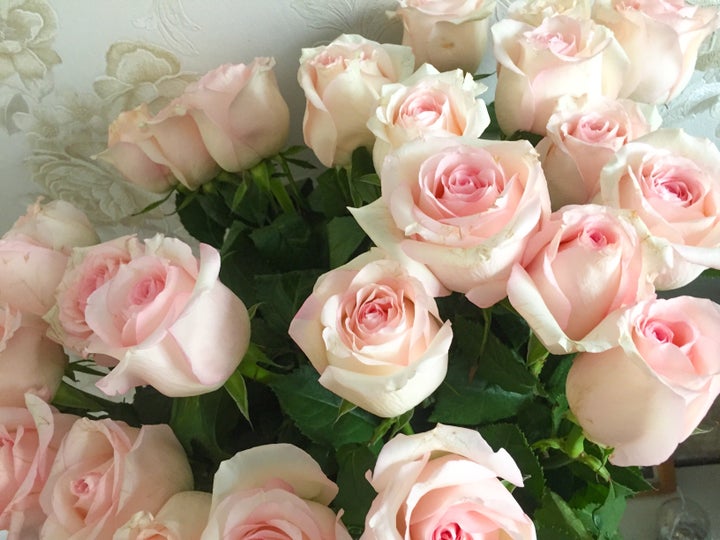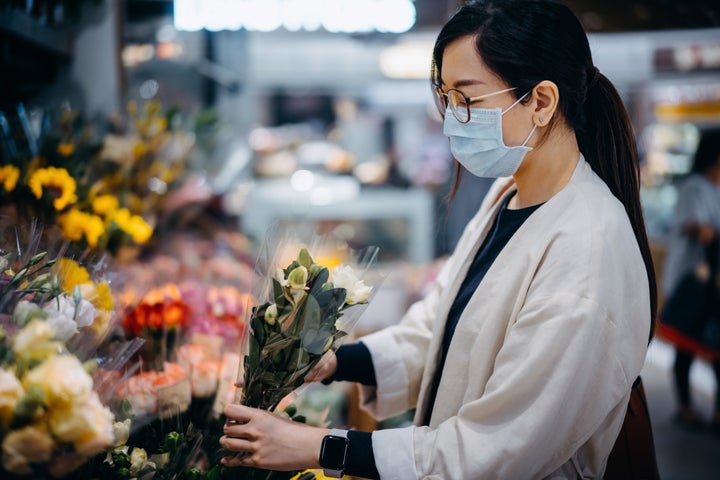
Mother’s Day 2020 is going to be a bit ... different compared to years past. There will be no group high-teas or other big in-person family gatherings.
Kids, who in most Aussie states and territories, have been learning from home until May 11, might not be bringing home cute crafts they made with their art teachers.
The holiday may feel less festive for families dealing with loss, economic hardship and other trauma amid the COVID-19 pandemic.
So people are getting creative and figuring out new ways to celebrate Mother’s Day while social distancing. They’re also trying to keep some traditional aspects alive through Zoom brunches, at-home crafts and even flower deliveries.
Many retailers in the flower industry are still operating and they’re offering Mother’s Day arrangements for delivery. But is it wise to send flowers to the mums in your life this year? HuffPost asked experts for their thoughts on the safety of Mother’s Day flowers in 2020 and their guidance for those who decide to go for it.
Consider the supply chain.
“The question is safe for whom? You the buyer? Your mother? The merchant? The grower?” said Jim Thomas, an associate professor of epidemiology at the University of North Carolina and lead author of the American Public Health Association’s code of ethics.
“Ordering online seems so antiseptic,” he said. “All we touch is our keyboards. But there are lots of interactions in the supply chain to get those flowers to appear at a door ― all of them an opportunity for transmission between each other.”
Your level of comfort with a flower delivery may depend on how you’ve felt about other types of deliveries amid the pandemic.
“Sending your mum flowers has no more risk than if you send her gifts from an online retailer or have a nice meal from a restaurant delivered,” said Brian Labus, a professor at the University of Nevada, Las Vegas’ School of Public Health. If you’re avoiding delivery food and nonessential packages, you’ll likely want to skip flower deliveries for the same reasons.
Keep it contactless.
“The risk of contracting infection is low, but caution must be exercised,” said Jagdish Khubchandani, an associate chair and professor of health science at Ball State University.
One way to exercise caution is to opt for contactless delivery.
“The risk from any delivery comes from the contact with the person making the delivery,” Labus noted. “Touchless delivery, which minimises contact with the person making the delivery, eliminates this risk, and this is very easy to do for floral deliveries.”
When placing your order, you can request that the delivery person leave the flowers on the porch or just outside the door or front gate, depending on the recipient’s living situation. If you and your mum live in the same area, you could also keep the handoff contactless by purchasing flowers at a grocery store or farmers market and dropping them off at her home yourself.

Choose a florist you trust.
Many different types of florists are still offering deliveries during the pandemic. Labus said the risks are the same with local and national services, especially because many of the national services partner with local florists.
But if you work with a local florist, he noted, “you can more easily discuss their delivery options and ensure that the flowers can be left outside the door without a signature.”
Khubchandani advised taking company reputation, reviews and treatment of delivery workers into consideration. He said he would be more likely to choose a local florist and call to ask about their hygiene and sanitation practices.
“Sellers must ensure delivery people are wearing masks and do not have any signs of flu-like illness,” he said.
From an economic standpoint, Thomas said he would feel more inclined to use a local florist and support a small business. But from a transmission standpoint, he thinks it’s “a hard call.”
“A local grower is more likely to sell on the street or in a farmers market, requiring you ― or someone shopping for you ― to go out in public to buy them,” he said. “Their supply chain is shorter and involves flowers passing through fewer hands, but then they interact with more customers.”
Advise handwashing.
Once your mum has received the flowers and placed them in a vase, she can exercise caution by washing her hands.
“There isn’t anything you need to do to the flowers themselves, other than remembering to keep them in water,” said Labus. “We generally recommend that people wash their hands after handling deliveries, so that it is a simple step your mum can take to help protect herself.”
As an extra precaution, Khubchandani suggested staying away from the flowers for at least one to two hours and wearing gloves or a plastic bag while handling them. If they’re already arranged in a vase or other holder, you can wipe that down with antiseptic wipes.
“No need to touch repeatedly or smell before a few hours pass,” he said. “Actually, just keep it in a place where you generally keep flowers. Cherish and be grateful.”
Whatever you do, keep social distancing.
Thomas noted that we’re still “in a fragile place” with the pandemic, and any reductions in social distancing measures should happen gradually and with markers like a decline in cases and greater availability of tests.
Less essential businesses “should remain closed or on pandemic footing for those that have adapted their business model,” he added. “Flowers are about as likely as anything to fall into the nonessential category. They don’t present a compelling reason to ask all the people involved to risk transmission.”
Labus emphasised complying with public health guidance and keeping any Mother’s Day festivities online (unless, of course, you and your mum are living in the same home or your state allows you to visit her home).
“Those of us who live near our mums are used to taking them flowers or gifts and taking them out to dinner for Mother’s Day,” he said. “While taking mum a meal and spending the day with her or taking the grandkids over to see her might seem like a nice alternative, that is one of the things that we should still avoid until the outbreak is over, especially if your mum is older or is at high risk for serious complications from coronavirus.”
Experts are still learning about the novel coronavirus. The information in this story is what was known or available as of press time, but it’s possible guidance around COVID-19 could change as scientists discover more about the virus. Please check the Centers for Disease Control and Prevention for the most updated recommendations.
- Stay up to date with our live blog as we cover the COVID-19 pandemic
- What happens if we end social distancing too soon?
- What you need to know about face masks right now
- How long are asymptomatic carriers contagious?
- Lost your job due to coronavirus? Here’s what you need to know.
- Everything you need to know about coronavirus and grief
- Parenting during the coronavirus crisis?
- The HuffPost guide to working from home
- What coronavirus questions are on your mind right now? We want to help you find answers.
- Everyone deserves accurate information about COVID-19. Support journalism without a paywall — and keep it free for everyone — by becoming a HuffPost member today.